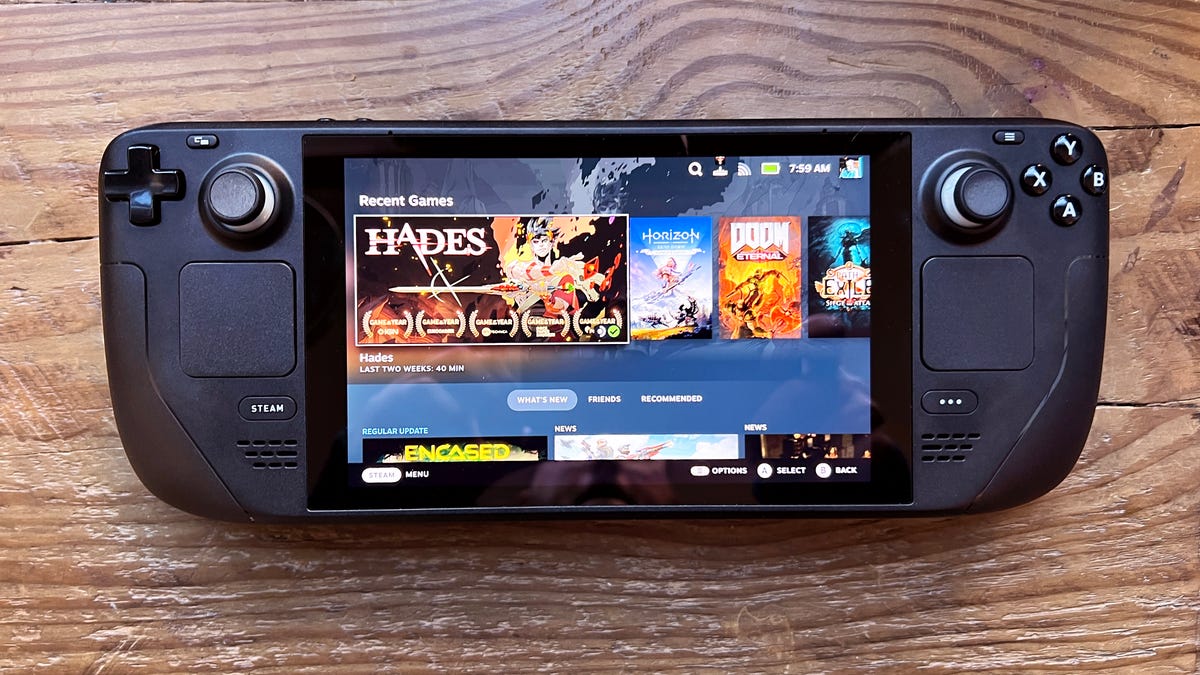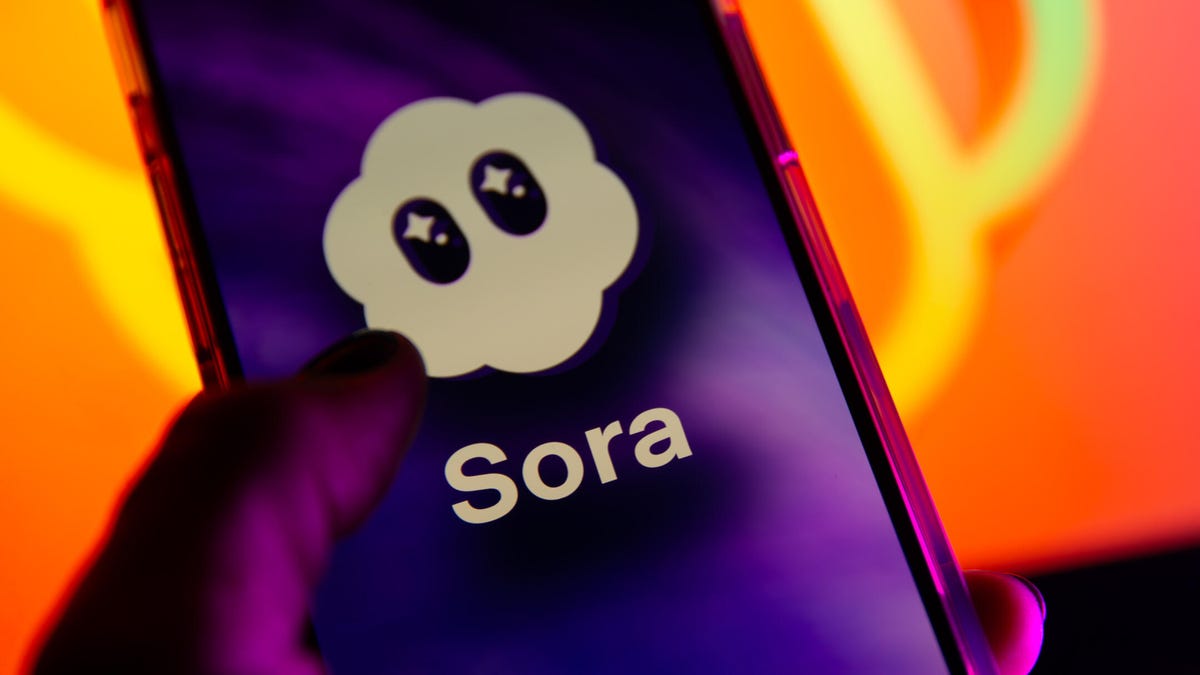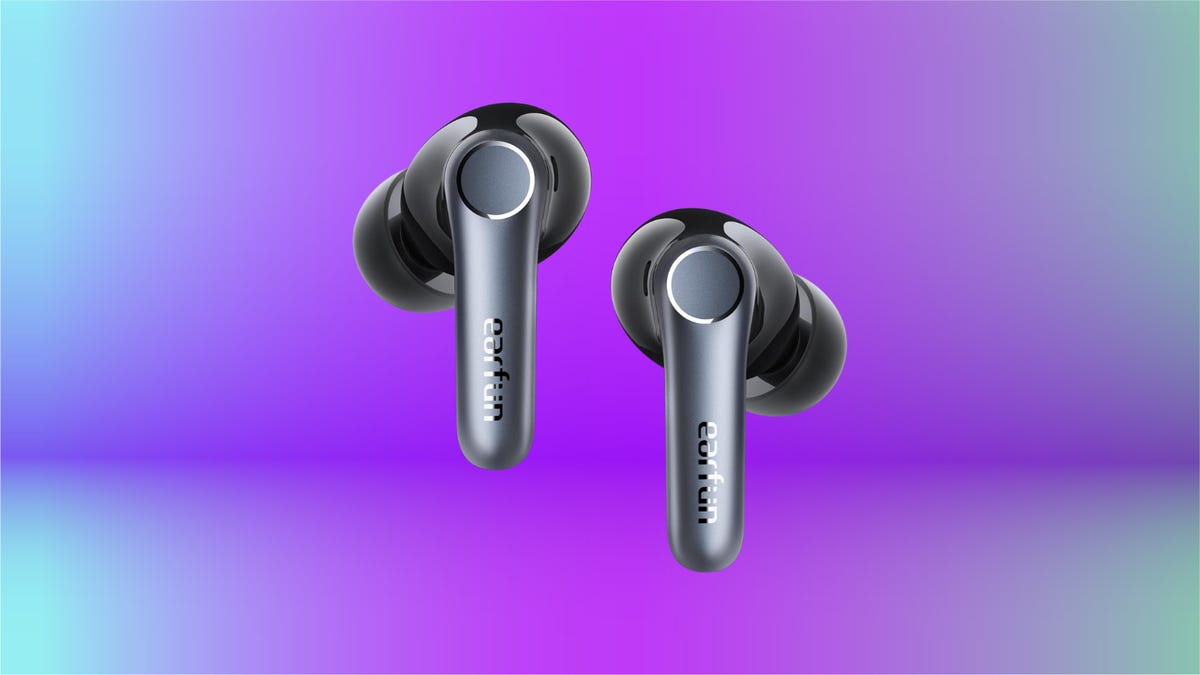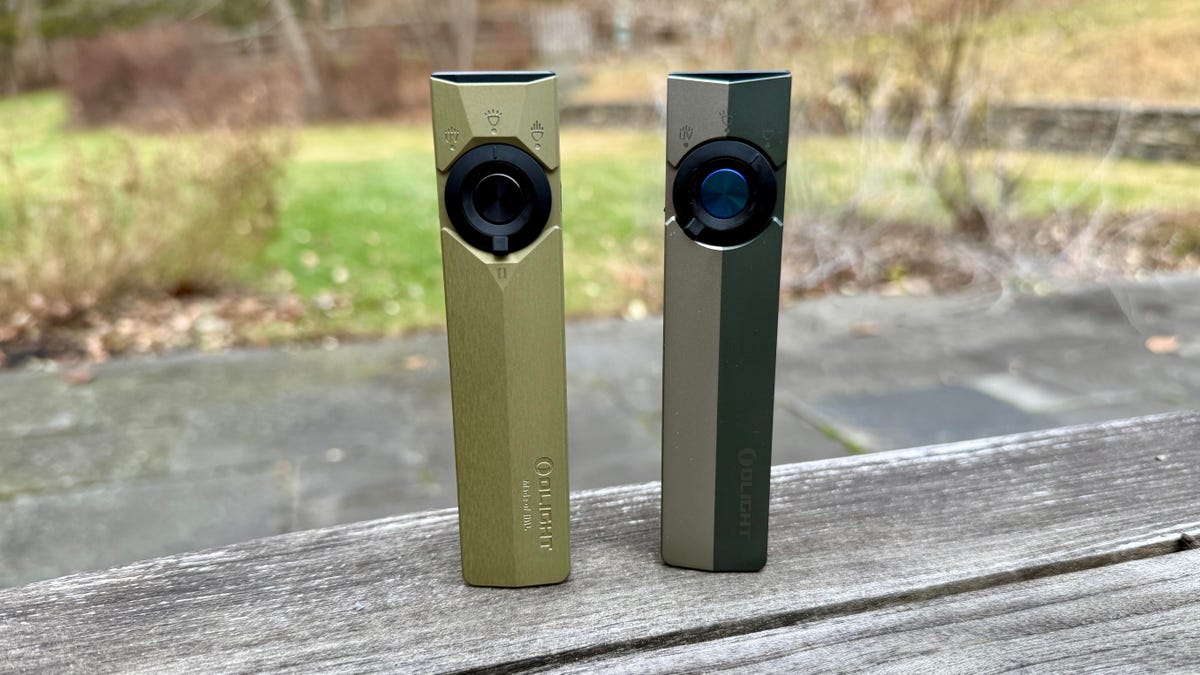Technologies
Game Handhelds Came Back This Year. Here’s What It Means for Gaming in 2023
The Nintendo Switch got new competition, and the future of gaming looks like it’ll be in our hands

Thanks to the Nintendo Switch, iPads, phones, VR headsets, and a ton of new gaming handhelds, I’m not gaming on my TV much anymore. In fact, gaming seems to be everywhere else other than the big panel hanging on my wall. Of course, that’s been the case before 2022. But thanks to the arrival of the Steam Deck and other handheld hardware, it feels like something’s finally happening that I’ve been waiting on for years: gaming tech is starting to become Switchified. I dreamed this would happen back in 2017.
Valve’s Steam Deck was the biggest new handheld arrival by far this year, and its popularity stands out on several fronts: as a gaming PC, it shows how software is finally starting to get more flexible and mobile, hopping between screens in a way that felt well overdue. But also, as another vehicle for streaming game services, it shows how gaming tech is starting to unbundle in a lot of strange ways.
The Nintendo Switch remains an aging, but strong, console. Mobile gaming feels like it’s starting to accelerate, thanks to cloud streaming apps and more excellent game controller cases, plus developments from mobile chip manufacturers like Qualcomm and new gaming tablets like the Razer Edge. Similarly, Logitech’s G Cloud handheld, arriving recently, is another flavor of mobile: a type of Android-based mobile device, but made to lean on game streaming.
And I didn’t even mention my favorite quirky indie handhelds, the Analogue Pocket and Panic Playdate, which have helped me rediscover tons of old games and plenty of indie newbies, too.
Can we also count VR headsets as handhelds? No, not really, although future devices like the Pimax Portal show some possibility for handhelds and VR to dovetail in ways you may not have been thinking about.
Here’s why it all matters.
Steam Deck: PCs can be handhelds now
Valve’s Steam Deck did it. The handheld Steam-compatible game system seemed like an impossible dream before it launched, but the hardware really does play tons of PC games well, and has proven to be one of the biggest gaming surprises of this year.
Valve doing it shows how other manufacturers could give it a go, too: in fact, companies like Dell and Razer already have, in a sense, via previous prototype experiments. The Steam Deck lives, though, and now there’s no reason not to make more of them.
The Steam Deck’s easy sleep/wake functions and its TV docking make it feel every bit as modular as a Switch, even if its controllers don’t detach. It’s the flexibility of the Steam Deck’s OS that shows a lot more promise. Running a variety of games or even apps, and being able to stream games, gives it the possibilities that we’d hoped the Nintendo Switch might gain someday. The Switch’s older processor limits what it can do, but the Steam Deck advances those ideas five years forward. Really, we knew this already with phones in our pockets that are as powerful as laptops, but gaming handhelds can do a lot more at also being full-fledged machines to connect to a much more cross-platform world.
I’m really curious where Valve goes next: in particular, to VR. Valve’s been active in VR for years, and is expected to make its own standalone «Deckard» VR headset in the near future. Could a new Steam Deck be compatible? It seems more than likely.
Stream Machines: Games can live anywhere
In a sense, Logitech’s G Cloud handheld and the Razer Edge tablet have a lot in common. CNET didn’t love the G Cloud, but the idea of it — an Android tablet with controls and the ability to stream games — is like a custom-made version of what you can already do with a phone or tablet and a game controller. The Razer Edge feels like a more advanced version of a similar idea, building a modular tablet with controllers around a higher-powered Qualcomm processor that’s capable of running games better, but also of streaming games as well.
These both remind me of the promises made way back by the Nvidia Shield, a tablet that was way ahead of its time and began to play with game streaming back in 2014.
Streaming games have finally come of age, both in the cloud and locally from console to handhelds. You may very well be doing this already with your phone or tablet. But, between the rise of very good game controller cases like the Backbone One and Razer Kishi and these types of specific standalone devices, it looks like mobile options could be multiplying.
Analogue Pocket and Panic Playdate: Rise of the new indies
Analogue’s ultimate retro handheld, the Pocket, and Panic’s crazy crank-enabled Playdate are very different pieces of hardware. Yet, they both point to a similar trend in gaming. The Pocket plays original Game Boy, Game Boy Advance and even Sega Game Gear game cartridges (with an adapter), and can run virtual hardware cores to recreate other game platforms. The Panic Playdate has its own season of included indie games that beam onto the handheld via Wi-Fi once a week. Both, however, can also sideload indie efforts made to run specifically on these systems.
Gaming portals like itch.io have become my most-visited places, as I check to see what experimental games people make available for Pocket or Playdate. Indie game designers create amazing efforts for all sorts of platforms: you don’t need a Playdate or Pocket for them. But these systems feel like vehicles that are ready to bring more indie efforts to life, and both feel like they’re living entirely outside of the world of the big game studios and hardware manufacturers. Maybe there’s room for more experimentation like this.
Could VR and AR be a doorway to more?
Arriving soon, the Pimax Portal is a curious sign of how tech could merge. Pimax, a manufacturer of VR headsets, is making a Switch-like Android gaming handheld that can also dock into a VR headset, becoming a handheld and standalone VR system all at once. It’s a return to the «VR goggles» concepts of early phone-based hardware like the Samsung Gear VR and Google’s Daydream, but in a potentially far more optimized and advanced format. I haven’t tried the Portal yet, but am really curious to. It’s an idea I could see more companies trying out, especially if it works better than those old limited-motion phone goggles.
Many upcoming VR headsets and AR glasses will start connecting with phones and smaller puck-like processors: the Magic Leap 2 is made this way, and Qualcomm’s next wave of AR glasses are designed to work with phones. Valve’s rumored standalone VR headset, Deckard, could possibly do the same with future Steam Decks.
Maybe Apple has similar plans in mind for how its VR headset will work with its phones and iPads. As headsets get smaller, more glasses-like, and lean on passthrough cameras and AR more, handheld accessories like game systems seem like a natural fit.
Nintendo had the right idea by making those Switch controllers slide off and work as little motion-sensitive magic wands…maybe the future of mobile gaming has been right in front of us all along.
Where this leads to in 2023
We’re already overdue for a truly new Nintendo Switch, and the Steam Deck seems bound for a sequel (although maybe not in 2023). We know a new wave of stand-alone VR headsets is on its way, and new phones and tablets are perpetual givens. The success of the Steam Deck, in particular, seems to open the door in ways that should impact both PC and console gaming. The Steam Deck was announced back in the middle of 2021, which means competitors have had a long time to prepare. But I’m also excited to see where truly decoupled indie gaming hardware could go: The Pocket and Playdate show all sorts of ways handhelds could live beyond traditional app store gateways. Cloud-connected gaming opens new pathways across hardware, too. It’s time for any mobile hardware to be more aware and flexible in its gaming strategies, because all the pieces are there. Of course, the handheld game system you’re most likely to be using in 2023 is your phone, but expect more dedicated gaming hardware to push the boundaries, too.
Technologies
Sora and Google’s Nano Banana Pro Are Slammed, and Scale Back Free Videos and Images
OpenAI and Google are reducing the number of image or video requests you can make on their latest media-generation platforms.

Maybe it’s because of the holiday weekend.
OpenAI’s video generator Sora and Google’s image generator nano banana pro are placing new limits on how many videos (in the case of Sora) and AI images (in the case of nano banana pro) you can make per day.
With more people using their Thanksgiving weekend idle time to, say, make AI videos of cats as angry service industry cashiers, it’s likely these services are hitting their limits.
Bill Peebles, OpenAI’s head of Sora, posted on X, «our gpus are melting, and we want to let as many people access sora as possible!» GPUs are the graphics processing units used by AI services for the complex computations they need to perform.
Peebles wrote that Sora will limit free video generation to six videos per day. ChatGPT Plus and Pro accounts won’t see any changes.
«And everybody can purchase additional gens as needed,» he wrote.
Don’t miss any of our unbiased tech content and lab-based reviews. Add CNET as a preferred Google source.
Gemini limits
As for Google’s image generator, a Gemini support page says that those without a Google AI plan are now limited to two images generated and edited per day with nano banana pro. The previous limit was three, according to 9to5Google, which also spotted new usage limits on Gemini 3 Pro that are variable. The same support page says free access to Gemini 3 Pro Thinking includes «Basic access — daily limits may change frequently.»
The limit for nano banana (the previous 2.5 non-pro version) is 100 free images per day.
A representative for Google did not immediately respond to a request for comment.
(Disclosure: Ziff Davis, CNET’s parent company, in April filed a lawsuit against OpenAI, alleging it infringed Ziff Davis copyrights in training and operating its AI systems.)
Technologies
If You Don’t Want to Pay AirPod Prices, I Found Great Noise Canceling Earbuds That Are Only $53 for Black Friday
You don’t need to spend a fortune to get a great pair of earbuds.

Black Friday deal alert: If you’re looking for a new pair of noise-canceling earbuds, there are some good deals on Apple AirPods right now, but you might be able to spend half as much to get similar performance. I’ve found that the Air Pro 4 earbuds from Earfun are legitimate contenders to the AirPods, at a much lower price. Right now at Amazon for Black Friday, you can get the Air Pro 4s for a steal — they’re 34% off, which drops their price down to $53.
In short, they’re great, and the black ones are currently available on Amazon for $53, near the lowest price we’ve ever seen them sell for. The other colors are also on sale; the glossy white and royal blue are both $68.
Hey, did you know? CNET Deals texts are free, easy and save you money.
HEADPHONE DEALS OF THE WEEK
-
$248 (save $152)
-
$170 (save $181)
-
$199 (save $150)
How these earbuds silence the noise around you
I prefer in-ear headphones because they offer active, electronic and passive noise cancellation. Passive noise cancellation basically consists of plugging your ears with the rubbery tips included with the earbuds.
The Earfuns fit well for me when I use the second-largest of the five swappable ear tip sizes, and they stay sealed and comfortable for hours. Sometimes I have to reseal one after I yawn or something, but that’s the case with other in-ear headphones, too.
For reading, I prefer Earfun’s «Strong ANC» noise-canceling mode, which makes a big difference when blocking out the noise around you, but there are a bunch of other noise-cancellation options. The Ambient Sound function is good for when I want to pay attention to my surroundings.
Overall, I found the app easier to use than Sony’s and just as capable. The main difference is that Sony’s app has a variable slider for ambient sound.
The Earfun app also includes a white noise section in the app. Normally, I prefer Spotify for white noise (and I download my favorite playlists for offline listening) but this feature is useful for people who don’t have another music service. It includes birdsong, waves and rainfall, all of which are short clips that repeat automatically.
Why I chose these earbuds over AirPods
These headphones have every other feature I’d expect, including the ability to connect to two devices simultaneously and programmable touch-sensitive controls on the buds. Plus, battery life has been more than ample for me, even after a marathon reading session.
There’s also a finder function if you misplace either earbud (unlike Apple FindMy, however, they have to be connected and in Bluetooth range). For actual music and voice calling quality, they sound fine, albeit not as good as my big Sonys.
I have an iPhone and briefly thought about buying Apple AirPods, but I didn’t want to spend the money. The AirPods 4 with noise cancellation cost $115 more than these Earfuns and have an open-ear design, so they rely entirely on the electronic (not passive) method. The AirPods Pro 2 are in-ear and superb, but I didn’t want to spend $250 on a pair of secondary headphones.
Yes, I could probably save some money on an even less expensive pair of in-ear noise-cancelling headphones, but I’m not sure I’d be as happy with their fit, long-term comfort, battery life and noise-cancellation performance. The Earfun Pro 4 buds help me relax and concentrate on my book, and for me that’s priceless.
For more headphone savings, check out our roundup of all the best deals on headphones, or find bargains of all kinds in our roundup of the best Amazon Prime Day deals going on now.
Join Our Daily Deals Text Group!
Get hand-picked deals from CNET shopping experts straight to your phone.
By signing up, you confirm you are 16+ and agree to receive recurring marketing messages at the phone number provided. Consent is not a condition of purchase. Reply STOP to unsubscribe. Msg & data rates may apply. View our Privacy Policy and Terms of Use.
Technologies
I Have a Flashlight Fetish and My Favorite New Olight Is 20% Off for Black Friday
Olight’s sleek new pocket flashlight, the ArkPro, is normally $100. But it’s down to $80 for Black Friday and Cyber Monday.

Truth be told be told, I have a thing for flashlights. Not a bad thing, just a certain appreciation for a well-designed torch, as the Brits might say.
Bright flashlights are good, naturally, but a small, sleekly designed rechargeable everyday carry flashlight that puts out a decent amount of light is high on my list of flashlight favorites, and the new Olight ArkPro and its slightly brighter sibling, the ArkPro Ultra, fit the bill. They’re both on sale for Black Friday and Cyber Monday for 20% off. The ArkPro is down to $80 ($100 list) while the ArkPro Ultra’s price has dipped to $104 ($130 list).
The flashlights are upgraded versions of Olight’s Arkfeld Pro ($70) and Arkfeld Ultra ($84), with higher brightness ratings. Both new models have similar flat, IPX7 waterproof designs with sturdy metal bodies and a magnetic base that allows you to attach the flashlight to anything metal. There’s also an integrated clip-on mount, and they come in cool white and neutral white color temperature versions.
You get three lighting modes: a 1,500-lumen floodlight mode (1,700 lumens for the ArkPro Ultra), an 800-lumen, 205-meter reach spotlight mode (it’s the same for the Ultra) and a UV light mode. You can also activate a green beam laser pointer.
The flashlights come with a wireless charger that magnetically attaches to the base, but you can also charge them via USB-C, which I found more convenient.
I mainly tested the flashlights while walking my dog at night in a pretty remote rural area in New York. The floodlight mode works better for dog walking, but I’d sometimes switch to spotlight mode when I wanted to gauge what was further ahead of us or check whether anything was lurking in the trees or bushes.
These smaller EDC flashlights are well-suited to a variety of activities, including camping and anything you’re doing where you’d like to have a flashlight handy that you can easily carry around in a pocket. You can find similar flat flashlight designs from other brands on Amazon — some of them for significantly less money. However, Olight is considered a premium EDC flashlight brand, though some flashlight enthusiasts are less enthusiastic about the brand for a few reasons. That said, I’m just fine recommending these new ArkPro models when they’re discounted like this. And they do make for nice gifts this time of year.
Join Our Daily Deals Text Group!
Get hand-picked deals from CNET shopping experts straight to your phone.
By signing up, you confirm you are 16+ and agree to receive recurring marketing messages at the phone number provided. Consent is not a condition of purchase. Reply STOP to unsubscribe. Msg & data rates may apply. View our Privacy Policy and Terms of Use.
-

 Technologies3 года ago
Technologies3 года agoTech Companies Need to Be Held Accountable for Security, Experts Say
-

 Technologies3 года ago
Technologies3 года agoBest Handheld Game Console in 2023
-

 Technologies3 года ago
Technologies3 года agoTighten Up Your VR Game With the Best Head Straps for Quest 2
-

 Technologies4 года ago
Technologies4 года agoBlack Friday 2021: The best deals on TVs, headphones, kitchenware, and more
-

 Technologies4 года ago
Technologies4 года agoVerum, Wickr and Threema: next generation secured messengers
-

 Technologies4 года ago
Technologies4 года agoGoogle to require vaccinations as Silicon Valley rethinks return-to-office policies
-

 Technologies4 года ago
Technologies4 года agoOlivia Harlan Dekker for Verum Messenger
-

 Technologies4 года ago
Technologies4 года agoiPhone 13 event: How to watch Apple’s big announcement tomorrow
